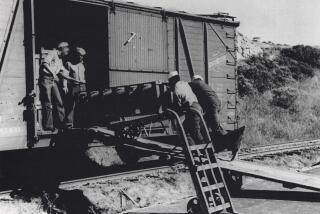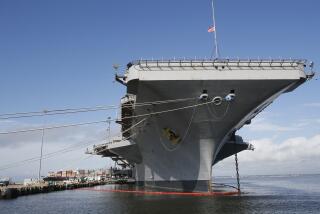Navy Apologizes for Tying Sailor to Blast : Military: It now says it doesn’t know what caused 47-death explosion on battleship Iowa. Seaman’s survivors don’t intend to drop $40-million suit.
- Share via
WASHINGTON — Two years after it laid the blame for a fatal shipboard explosion on one sailor, the U.S. Navy concluded Thursday that it does not know what caused the April, 1989, blast aboard the battleship Iowa and apologized to the family of the dead serviceman.
Adm. Frank Kelso, the chief of naval operations, announced that, “after reviewing all evidence” in the Navy’s reopened investigation of the explosion in one of the ship’s 16-inch-gun turrets, “the exact cause cannot be determined.”
Kelso’s comments mark a dramatic and painful reversal for the Navy, which had announced in October, 1989, that the blast was “most probably” the intentional act of a single sailor, Gunner’s Mate Clayton M. Hartwig.
Hartwig, who died, along with 46 others, in the conflagration, was said by the Navy to have been distraught over the deterioration of a friendship with Petty Officer Kendall L. Truitt, an Iowa shipmate.
That conclusion drew fire on several fronts, with some lawmakers arguing that the Navy is incapable of objectively investigating accidents aboard its ships.
On Thursday, Kelso called the Navy’s earlier finding a “qualified opinion” that “was interpreted by many as a conclusive finding of wrongdoing.”
“For this, on behalf of the U.S. Navy, I extend my sincere regrets to the family” of Hartwig, he said.
Kelso’s apology was greeted with joy by Hartwig’s family, which has mounted a two-year campaign to get the Navy to withdraw its charge and clear the name of the enlistee, who was 25 when he died.
“I’m totally happy about the way everything went,” said Kathleen Kubicina, Hartwig’s sister, who was briefed Thursday at her parents’ home in Cleveland by the Navy. “All we’ve ever wanted is for them to show concrete physical evidence my brother did it, and they couldn’t, so the only alternative was for them to apologize.”
Hartwig’s family sued the Defense Department and the Navy last April for intentional and negligent infliction of emotional distress, seeking $40 million in damages. “We have no reason at this point to drop the suit,” Kubicina said in a telephone interview.
The Navy’s comments followed completion of a second inquiry ordered by Navy Secretary H. Lawrence Garrett III in May, 1990, after scientists testing Navy gunpowder experienced an “unexplained ignition.”
The test explosion offered the first firm evidence that the original blast aboard the Iowa might have been an accident and not the work of Hartwig.
Firing of the Iowa’s 16-inch guns was banned for several months after the explosion, but their use was permitted again in the wake of the Navy’s first finding, presented in September, 1989.
During the Persian Gulf War and the months leading up to it, two other Navy battleships, the Wisconsin and Missouri, fired 1,182 rounds of 16-inch gunfire without incident under combat conditions.
Kelso said that the test explosion that caused the inquiry to be reopened was created under laboratory conditions and was a low-probability event. It was even more difficult, he added, to recreate the ignition in a real 16-inch-gun turret.
Kelso called the Navy’s first investigation, directed by Rear Adm. Richard D. Milligan, “an honest attempt to weigh impartially all the evidence as it existed at the time.”
“There is one conclusion we can draw with confidence,” he added. “Our battleship 16-inch guns and their ammunition are safe to fire. It is an assurance we owe to all our sailors, their families and the American people.”
More to Read
Sign up for Essential California
The most important California stories and recommendations in your inbox every morning.
You may occasionally receive promotional content from the Los Angeles Times.













